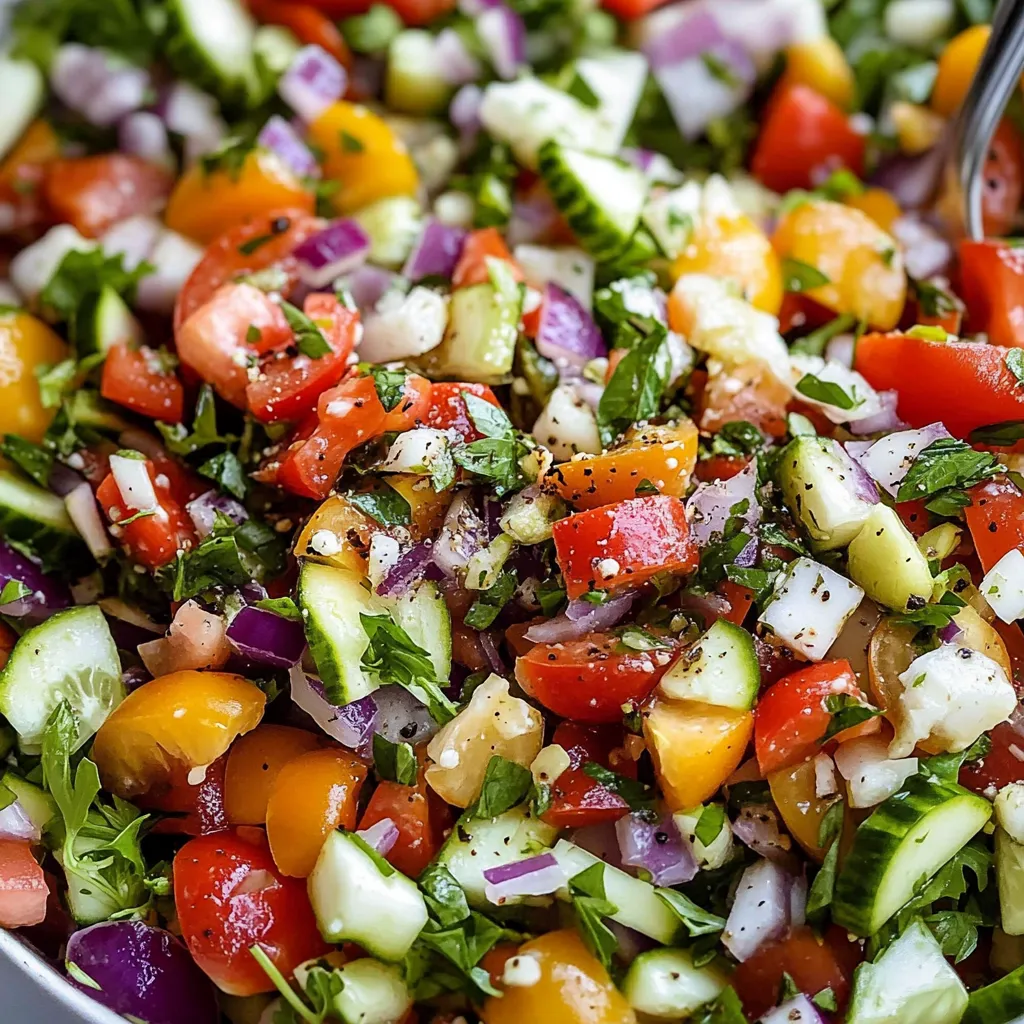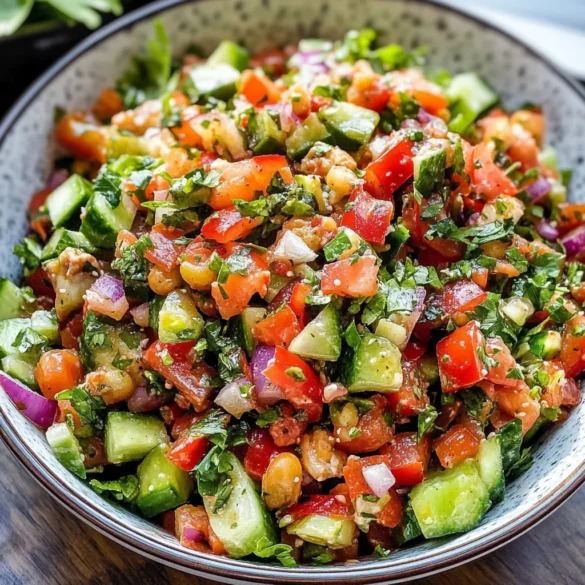This irresistible Mediterranean Salad transforms the timeless ingredients of the Mediterranean basin into the ultimate celebration of coastal cuisine with its perfect balance of crisp vegetables, briny olives, creamy cheese, and aromatic herbs all unified by a golden olive oil dressing that captures the essence of sun-drenched shores. The recipe showcases the beautiful simplicity of Mediterranean cooking, featuring ripe tomatoes that burst with summer sweetness, crisp cucumbers that add refreshing crunch, tangy feta cheese that provides creamy saltiness, and fresh herbs that contribute aromatic brightness, all enhanced by the region’s liquid gold—extra virgin olive oil. Every bite delivers an exquisite harmony—the juicy tomatoes and cool cucumbers create refreshing contrast while the olives add briny depth, the feta contributes creamy richness, and the herbs provide fresh, aromatic notes that transport you to hillside tavernas overlooking azure waters. The salad’s visual appeal of vibrant reds, crisp greens, creamy whites, and deep purples creates a stunning mosaic that mirrors the colorful markets and coastal landscapes of the Mediterranean. This versatile dish exemplifies healthy, flavorful eating at its most appealing—ideal for summer entertaining, light dinners, healthy lunches, or anytime you crave the clean, satisfying flavors that have nourished Mediterranean cultures for thousands of years.
Why You’ll Love This Recipe
- Authentic Mediterranean flavors: Captures the essence of coastal cuisine traditions
- Heart-healthy ingredients: Features olive oil, vegetables, and anti-inflammatory foods
- Quick and fresh: Requires no cooking and celebrates raw ingredient quality
- Visually stunning: Creates beautiful presentation with vibrant natural colors
- Versatile serving: Works as side dish, light meal, or elegant appetizer
- Make-ahead friendly: Actually improves as flavors meld and develop
- Nutritionally dense: Packed with vitamins, healthy fats, and antioxidants
- Budget-conscious: Uses simple, affordable ingredients for maximum impact
- Dietary flexible: Naturally vegetarian and easily adaptable to various needs
- Timeless appeal: Classic combination that never goes out of style
Ingredients
For the Vibrant Vegetable Base
- Ripe tomatoes – Provide juicy sweetness and vibrant red color
- English cucumber – Adds refreshing crunch and cooling element
- Red bell pepper – Contributes sweet flavor and beautiful color contrast
- Red onion – Provides sharp bite and purple color accent
- Kalamata olives – Add authentic briny, fruity Mediterranean flavor
- Green olives – Contribute different brine profile and color variety
- Fresh parsley – Provides bright, grassy herb notes
- Fresh basil – Adds sweet, aromatic Mediterranean character
For the Creamy Cheese Element
- Feta cheese – Creates authentic Mediterranean creaminess and tang
- Fresh mozzarella – Optional for milder, creamier texture
- Ricotta salata – Alternative aged cheese for different flavor profile
- Goat cheese – Provides tangy creaminess with distinctive character
For the Golden Olive Oil Dressing
- Extra virgin olive oil – Forms the heart of Mediterranean cuisine
- Fresh lemon juice – Adds essential brightness and acidity
- Red wine vinegar – Contributes depth and traditional tang
- Garlic cloves – Provide aromatic pungency and depth
- Dried oregano – Adds classic Mediterranean herb flavor
- Sea salt – Enhances and balances all flavors
- Black pepper – Provides subtle warmth and complexity
Optional Enhancements
- Artichoke hearts – Add meaty texture and tangy flavor
- Chickpeas – Provide protein and substance for main course
- Pine nuts – Contribute buttery crunch and richness
- Sun-dried tomatoes – Intensify tomato flavor with concentrated sweetness
- Capers – Add briny bursts of intense flavor
- Fresh mint – Provide cooling, aromatic freshness
- Pepperoncini – Add mild heat and pickled tang
- Anchovies – Traditional protein for authentic Caesar-style depth
- Bulgur wheat – Create substantial tabbouleh-style variation
Step-by-Step Instructions
Preparing the Fresh Vegetables
- Select the ripest, most flavorful tomatoes available—choose 4-5 medium tomatoes that give slightly to pressure and have deep color and fragrant aroma, as these will form the flavor foundation of your salad.
- Core the tomatoes and cut them into bite-sized wedges or chunks, removing any tough white core areas while preserving the juicy flesh and seeds that contribute to authentic Mediterranean flavor.
- Place the cut tomatoes in a large mixing bowl and sprinkle lightly with sea salt, allowing them to sit for 10-15 minutes to draw out their natural juices and concentrate their sweet flavor.
- Wash and dice 1 large English cucumber (or 2 regular cucumbers, peeled and seeded) into uniform ½-inch pieces, maintaining the skin for color contrast and nutritional benefits.
- Remove seeds and white pith from 1 large red bell pepper, then dice into pieces similar in size to the cucumber for consistent texture and attractive presentation throughout the salad.
- Slice ½ medium red onion as thinly as possible using a sharp knife or mandoline, then soak the slices in ice water for 10 minutes to mellow their sharpness while maintaining crunch.
- Drain and rinse ½ cup each of Kalamata and green olives, then roughly chop them to distribute their briny flavor more evenly throughout the salad rather than having whole olives.
- Roughly chop ¼ cup of fresh parsley and 2 tablespoons of fresh basil, keeping the pieces relatively large to maintain their fresh appearance and prevent them from becoming mushy during mixing.
Creating the Authentic Mediterranean Dressing
- In a small bowl, whisk together ⅓ cup of premium extra virgin olive oil with 3 tablespoons of fresh lemon juice, creating the essential fat and acid balance that defines Mediterranean cuisine.
- Add 1 tablespoon of red wine vinegar to enhance the acidity and provide additional depth of flavor that complements the olive oil’s richness without overwhelming the fresh ingredients.
- Mince 2 garlic cloves very finely and add to the oil mixture along with 1 teaspoon of dried oregano, ½ teaspoon of sea salt, and ¼ teaspoon of freshly ground black pepper.
- Whisk the dressing vigorously for 30 seconds to create a temporary emulsion, then taste and adjust the balance of oil, acid, and seasonings according to your preference and the strength of your ingredients.
- Let the dressing sit at room temperature for 15-20 minutes to allow the garlic and herbs to infuse their flavors into the oil, creating a more complex and aromatic final product.
- Just before using, whisk the dressing again to recombine all ingredients, as separation is natural and doesn’t affect the final flavor or quality of the salad.
Assembling the Mediterranean Salad
- Drain any accumulated juices from the salted tomatoes, then add the prepared cucumber, red bell pepper, and drained red onion to the bowl, creating a colorful vegetable medley.
- Add the chopped olives and fresh herbs to the vegetable mixture, tossing gently with clean hands or large spoons to distribute all ingredients evenly without bruising the delicate herbs.
- Crumble ½ cup of feta cheese over the vegetables, breaking it into bite-sized pieces that will provide creamy contrast and salty depth throughout each serving of the finished salad.
- Pour the prepared dressing over the salad ingredients, starting with about three-quarters of the dressing and reserving the remainder for final adjustments based on taste and texture preferences.
- Using clean hands or salad tongs, gently toss all ingredients together until everything is evenly coated with dressing and the flavors begin to meld, being careful not to break up the feta cheese too much.
- Taste the salad and adjust seasonings, adding more dressing, salt, pepper, or lemon juice as needed to achieve the perfect balance of flavors that represents authentic Mediterranean cuisine.
Final Presentation and Serving
- Allow the assembled salad to rest at room temperature for 20-30 minutes before serving, which permits the flavors to meld and the vegetables to absorb the aromatic dressing properly.
- Transfer to a beautiful serving bowl or individual plates, arranging the colorful ingredients attractively to showcase the natural beauty and vibrant colors of the Mediterranean ingredients.
- Garnish with additional fresh herb sprigs, a few whole olives, and extra crumbled feta cheese for visual appeal and to indicate the salad’s flavor profile to your guests.
- Provide good crusty bread, pita, or focaccia alongside the salad for authentic Mediterranean dining experience and to help guests enjoy every drop of the flavorful dressing.
- Serve with additional lemon wedges and extra virgin olive oil at the table, allowing diners to adjust the acidity and richness according to their personal preferences.
- Store any leftover salad in the refrigerator for up to 2 days, though it’s best enjoyed fresh as the vegetables will gradually soften and the herbs will lose their bright color over time.

Pro Tips
- Use the ripest, most flavorful tomatoes available for best results
- Salt tomatoes beforehand to concentrate flavors and remove excess water
- Dice all vegetables to similar sizes for consistent eating experience
- Soak red onion in ice water to mellow harsh, sharp flavors
- Use high-quality extra virgin olive oil as it’s the star ingredient
- Let dressing infuse at room temperature before using for deeper flavors
- Allow salad to rest before serving for optimal flavor development
- Don’t overdress—vegetables should be coated, not swimming
- Add feta cheese just before serving to prevent it from breaking down
- Use fresh herbs rather than dried for brightest color and flavor
- Serve at room temperature for optimal flavor perception
- Provide crusty bread for authentic Mediterranean dining experience
- Taste and adjust seasoning balance throughout preparation process
- Choose mixed olive varieties for complex briny flavor profiles
- Store leftover salad properly but consume within 2 days for best quality
- Use clean hands for gentle mixing to avoid bruising ingredients
- Quality ingredients make the biggest difference in final results
- Fresh lemon juice is essential—avoid bottled substitutes
- Consider seasonal variations using peak produce for best flavors
- Garnish simply to let natural ingredient beauty shine through
Variations and Creative Ideas
Regional Mediterranean Variations
- Greek Village Style: Add chunks of cucumber, green peppers, and generous amounts of feta with traditional Greek oregano for authentic horiatiki salad that emphasizes rustic, village-style preparation.
- Italian Caprese Influence: Feature fresh mozzarella, basil, and the best tomatoes available with balsamic glaze for Italian-inspired variation that celebrates the classic Caprese flavor combination.
- Spanish Gazpacho Salad: Include diced bread cubes, sherry vinegar, and Spanish olives for Andalusian-inspired variation that captures the essence of gazpacho in salad form.
- Turkish Mediterranean: Add pomegranate seeds, sumac, and Turkish white cheese for Middle Eastern variation that provides tart, fruity notes and distinctive regional character.
Protein Additions for Main Course
- Grilled Chicken Mediterranean: Add sliced grilled chicken breast marinated in herbs and lemon for substantial main course that maintains fresh, healthy character while providing complete protein.
- Chickpea Protein Boost: Include drained and rinsed chickpeas for vegetarian protein that adds substance and fiber while maintaining traditional Mediterranean dietary patterns.
- Tuna Niçoise Style: Add high-quality tuna (canned or fresh) with hard-boiled eggs for French Riviera-inspired variation that creates substantial, satisfying main course appeal.
- Grilled Shrimp Elegance: Include grilled shrimp seasoned with garlic and herbs for sophisticated seafood variation that maintains coastal Mediterranean character while adding protein.
Seasonal and Ingredient Adaptations
- Winter Roasted Vegetable: Use roasted winter vegetables like eggplant, zucchini, and bell peppers for warm variation that extends Mediterranean flavors into cooler months.
- Spring Artichoke Fresh: Feature fresh or marinated artichoke hearts, asparagus, and spring onions for seasonal variation that celebrates early Mediterranean produce.
- Summer Peak Harvest: Maximize summer tomatoes with multiple varieties, fresh corn, and peak-season herbs for ultimate summer Mediterranean celebration with maximum seasonal appeal.
- Preserved Ingredient Focus: Emphasize preserved lemons, sun-dried tomatoes, and marinated vegetables for concentrated Mediterranean flavors that work year-round.
Grain and Substance Additions
- Quinoa Mediterranean Bowl: Add cooked quinoa for substantial grain bowl that provides complete protein while maintaining fresh Mediterranean flavors and creating satisfying main course.
- Farro Ancient Grain: Include cooked farro for nutty, chewy texture that adds substance and traditional Mediterranean grain character while providing fiber and nutrients.
- Bulgur Tabbouleh Style: Add bulgur wheat with extra parsley and mint for tabbouleh-inspired variation that creates more substantial, traditional Middle Eastern character.
- Orzo Pasta Salad: Include cooked orzo pasta for Mediterranean pasta salad variation that transforms the fresh salad into heartier, more filling side dish or main course.
Frequently Asked Questions
How do I choose the best tomatoes for this salad?
Choose tomatoes that are fully ripe with deep color, slight give when gently pressed, and strong tomato aroma at the stem end. Avoid perfectly firm tomatoes which lack flavor, or overly soft ones that will make the salad watery. Heirloom varieties often have superior flavor, but any ripe, in-season tomato will work better than out-of-season greenhouse varieties. If good fresh tomatoes aren’t available, consider using high-quality canned tomatoes, drained and chopped.
Can I make this salad ahead of time?
This salad actually improves when made 30 minutes to 2 hours ahead as the flavors meld beautifully. However, add the feta cheese and fresh herbs just before serving to maintain their texture and color. For longer storage, keep the dressing separate and combine just before serving. The salad will keep in the refrigerator for up to 2 days, though the vegetables will soften and the overall texture will change from crisp to more melded.
What’s the best olive oil to use for authentic Mediterranean flavor?
Use the highest quality extra virgin olive oil you can afford, as it’s the foundation of Mediterranean cuisine. Look for oils with harvest dates (within the last year), stored in dark bottles, and from reputable Mediterranean regions like Greece, Italy, or Spain. The oil should taste fruity with some peppery notes—if it tastes flat or rancid, it will negatively impact your salad. For this salad, a medium-intensity oil works best as it won’t overpower the vegetables.

Ingredients
For the Vibrant Vegetable Base:
4-5 medium ripe tomatoes, cut into wedges
1 large English cucumber, diced
1 large red bell pepper, diced
½ medium red onion, thinly sliced
½ cup Kalamata olives, pitted and chopped
½ cup green olives, pitted and chopped
¼ cup fresh parsley, chopped
2 tablespoons fresh basil, chopped
For the Creamy Cheese Element:
½ cup feta cheese, crumbled
Extra feta for garnish
For the Golden Olive Oil Dressing:
⅓ cup extra virgin olive oil
3 tablespoons fresh lemon juice
1 tablespoon red wine vinegar
2 garlic cloves, minced
1 teaspoon dried oregano
½ teaspoon sea salt
¼ teaspoon black pepper
For Garnish and Serving:
Extra fresh herb sprigs
Lemon wedges
Crusty bread or pita
Additional olive oil for drizzling
Instructions
Cut tomatoes into wedges, place in bowl, and sprinkle with salt. Let sit 10-15 minutes.
Dice cucumber and red bell pepper into ½-inch pieces for consistent texture.
Slice red onion thinly and soak in ice water 10 minutes to mellow sharpness.
Roughly chop both olive varieties and fresh herbs, keeping pieces substantial.
Make dressing by whisking olive oil, lemon juice, vinegar, minced garlic, oregano, salt, and pepper.
Let dressing sit 15-20 minutes at room temperature for flavors to infuse.
Drain tomatoes and add cucumber, bell pepper, and drained onion to bowl.
Add chopped olives and herbs, toss gently to distribute evenly.
Crumble feta over vegetables and pour three-quarters of dressing over salad.
Toss gently and let rest 20-30 minutes. Adjust seasoning and serve with bread.
Notes
Use ripest, most flavorful tomatoes available for optimal taste foundation
Salt tomatoes beforehand to concentrate flavors and remove excess moisture
Dice all vegetables to similar sizes for consistent, appealing eating experience
Soak red onion in ice water to mellow harsh, sharp flavors significantly
Use highest quality extra virgin olive oil as it's the star ingredient
Let dressing infuse at room temperature before using for deeper, richer flavors
Allow salad to rest before serving for optimal flavor development and melding
Don't overdress—vegetables should be lightly coated, not swimming in dressing
Add feta cheese just before serving to prevent it from breaking down
Use fresh herbs rather than dried for brightest color and most vibrant flavor
Serve at room temperature for optimal flavor perception and enjoyment
Provide crusty bread for authentic Mediterranean dining experience and tradition
Taste and adjust seasoning balance throughout entire preparation process
Choose mixed olive varieties for complex, interesting briny flavor profiles
Store leftover salad properly but consume within 2 days for best quality
Use clean hands for gentle mixing to avoid bruising delicate ingredients
Quality ingredients make the biggest difference in final results and satisfaction
Fresh lemon juice is essential—avoid bottled substitutes which lack brightness
Consider seasonal variations using peak produce for best possible flavors

